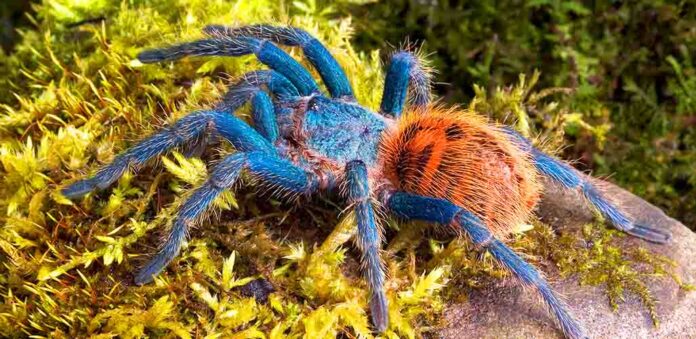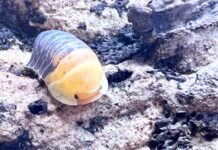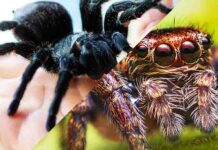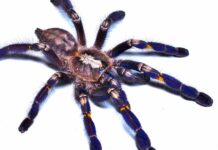Green bottle blue tarantulas are one of the tarantula species most commonly recommended for novice spider keepers. Arachnologists appreciate them for their striking colors, and undemanding care needs. Their venom is relatively mild too, but that’s because they have another impressive defense strategy owners need to be prepared for as well! In this complete guide to the green bottle blue tarantula, we take a look at what makes these spiders good pets, and what you’ll need to take care of one.
Contents
- What are green bottle blue tarantulas?
- Green bottle blue tarantula appearance
- Are green bottle blue tarantulas poisonous?
- How big do green bottle blue tarantulas get?
- Are green bottle blue tarantulas good for beginners?
- Green bottle blue tarantula temperament
- Are green bottle blue tarantulas aggressive?
- Caring for a green bottle blue tarantula
- Green bottle blue tarantula lifespan
- How to find a green bottle blue tarantula for sale
- Is a green bottle blue tarantula right for me?
Green bottle blues are particularly noted for the complex and beautiful web structures they build in their enclosure, like the one you can see in this video. Let’s discover what else makes them special…
What are green bottle blue tarantulas?
Green bottle blues are a tarantula species from the Paraguana Penninsula on the north coast of Venezuela. Their name is a bit of a mouthful and easily muddled up, so they are also sometimes referred to
- as a green blue bottle tarantula (by accident)
- or a blue bottle green tarantula (by accident)
- by the handy abbreviation GBB tarantula (for those in the know!)
- and by their latin name Chromatopelma cyaneopubescens.
To date, over 1,000 different species of tarantula have been observed and recorded worldwide, so unsurprisingly arachnologists also use a variety of ways of arranging them into smaller categories. Here are some of the categories that the green bottle blue fits into:
- They are one of the New World species. New World tarantula species tend to be more docile, and they have urticating hairs on their abdomen. Those hairs are going to be important later, so remember them!
- They are semi-arboreal. Most tarantulas are either terrestrial, meaning they live on the ground and rest in a horizontal position, or arboreal, meaning they live in trees and rest in a vertical position. GBBs are unusual for enjoying a bit of both!
- They are an arid species. Tarantulas can be divided into species which need high humidity, and species which need low humidity. The green bottle tarantula is adapted to live in dry grasslands, so they need relatively low humidity.
Green bottle blue tarantula appearance
A greenbottle blue spider is so called because their legs and carapace (the front-most section of their body) are a remarkable, vivid blue-green color. This color starts to appear when they are about half-grown, and gets more vivid with each molt until they reach maturity. Their abdomen is a contrasting bronze-gold color. Juvenile GBBs (known as slings or spiderlings) are almost impossible to tell apart by sex. But mature males can be distinguished from mature females by careful examination of their final molt (shed skin).
How big do green bottle blue tarantulas get?
Green bottle blues achieve a leg span of up to 4 to 6 inches. Their body, from chelicerae (the fang bearing mouthparts at the front of their body) to spinnerets (the silk spinning organs on their butt) can reach 2.75 inches long. This is firmly ‘middle-sized’ among tarantula species. For comparison, some dinky dwarf species have a leg span of less than 3 inches, whilst the appropriately named goliath birdeater tarantula can reach a whopping 12 inches from toe to toe.
Are green bottle blue tarantulas poisonous?
Technically tarantulas are venomous rather than poisonous. Remember: if you bite into it and it makes you sick it’s poisonous, and if it bites into you and makes you sick, it’s venomous! Green bottle blue tarantulas are venomous, but like most New World tarantulas their bite is comparable to a bee sting, and is rarely fatal in humans. The reason they can afford to have a less venomous bite is because they rely on their urticating hairs instead as their main form of defence. Urticating hairs are fine, tiny hairs on their abdomen, which they can flick into the air with their legs. If the hairs land on your skin or in your eyes they cause irritation. Some tarantula owners have even developed an anaphylactic allergic reaction from repeated exposure to urticating hairs, and some have needed surgery to treat complications of urticating hairs embedded in their eyes.
Green bottle blue tarantula temperament
New World tarantula species are generally observed to be docile than Old World species. But, the GBB tarantula is something of an exception! Arachnologists often describe them as skittish and nervous. They tend to be quick to get out of the way of anything entering their tank, and they move faster than a lot of the other popular tarantula species.
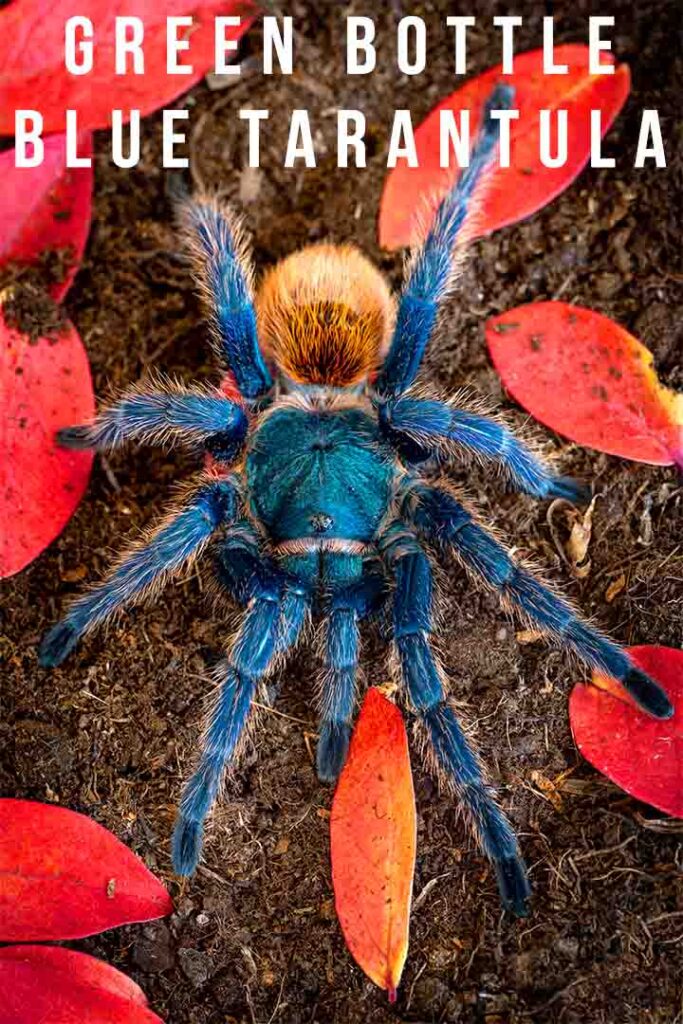
For these reasons, most experienced tarantula owners advise against trying to handle a GBB. However, it’s something of a myth that slower, more docile species are suitable for handling. Handling is stressful for all tarantulas, and many arachnologists and veterinarians recommend that they should be left in peace and always admired in a hands-off way through the glass of their tank. So if being able to handle your pet is important to you, don’t just rule out the green bottle blue – rule out tarantulas altogether!
Are green bottle blue tarantulas aggressive?
Green bottle blues have adapted to rely on defence rather than attack, whenever possible. When confronted with an unwanted situation, they are more likely to run away in a cloud of urticating hairs than try to land a bite. So they are not particularly aggressive, but as we’ve seen they don’t like being handled either. And they are highly likely to respond in a defensive way if you try. For your safety, always cover your skin and wear glasses to feed a GBB or tend to their enclosure.
Caring for a green bottle blue tarantula
An important reason the GBB tarantulas are so often recommended for beginners is because they are relatively easy to look after. Before getting your first tarantula it’s a good idea to research what care they need extensively, and find a more experienced owner willing to mentor you and answer questions as you get set up. Here are some of the things they need, to give you an idea:
Starter checklist
A tank about 12-18” tall, long and wide. Tarantulas are ideal for apartment dwellers because they feel safer and more confident (and therefore tend to be more active) in modest sized enclosures. Tarantulas in overly large enclosures tend to remain hidden more. But, make sure the tank has enough space for them to comfortably climb out of their old exoskeleton next time they molt. Also make sure their tank closes securely – this semi-arboreal species is a competent climber, which makes them extra hard to find if they escape!
Tank furnishings. Greenbottle blue tarantulas are an arid species, which means they need a dry substrate in the bottom of their tank, and humidity of 30-50%. This is great because it makes it much easier to keep their habitat free from bacterial and fungal build up. This species loves having a gnarly, multi-limbed piece of tree root to construct elaborate funnels of webwork on.
An ambient temperature of 60-70f. Or in other words, they are usually happy at room temperature. If you are warm enough, so are they!
Live food. Tarantulas’ feeding instincts are triggered by the movement of live prey. You can feed them crickets, wax worms and immature cockroaches. They only need feeding one a week, and they tend to fast immediately before and after molting.
Fresh water. GBBs get most of the water they need from their food, but don’t overlook the importance of providing fresh water too – dehydration is a common problem veterinarians see in tarantulas.
Green bottle blue tarantula lifespan
Like all tarantula species, a green bottle blue male doesn’t live much longer after reaching sexual maturity. Their lifespan is usually around 4 years. On the other hand, females can live for 14 years! During that lifetime, some health problems to be alert for are:
- Dehydration
- Parasitic infections such as mites
- Fungal and bacterial infections
- Wounds and injuries inflicted by too-large prey
- Difficulty molting
- Dyskinetic syndrome
Not all veterinarians are qualified or comfortable treating spiders, so it’s a good idea to find the contact details of a suitable clinic before you need them.
Are green bottle blue tarantulas good for beginners?
Green bottle blue tarantulas are one of the species most likely to be recommended for a beginner spider keeper. The reasons are:
- Their venom is mild.
- It’s relatively easy to protect yourself from the urticating hairs by covering your skin and wearing eye protection when you open their tank.
- They build elaborate web structures and funnels in their enclosure, which make them fascinating to observe.
- They are low maintenance – their tank is perfect at room temperature and room humidity.
How to find a green bottle blue tarantula for sale
Members of the spider-keeping community sometimes describe GBBs as ‘easy to keep but hard to breed’. Females are more than averagely likely to reject a potential suitor and attack him rather than mate with him. However, when mating is successful, the female will produce up to 100 eggs, so when it works, it really works!
Green bottle blue spiderlings (known as slings) are widely sold online by members of the spider keeping hobby community, and they can be safely transported by post until their leg span is about 1 inch. Slings usually cost around the $50 dollar mark, but a mature female can swap hands for up to $300. Bear in mind that once a female GBB reaches sexual maturity there is no way to tell how old she is other than to take the seller’s word for it!
Is a green bottle blue tarantula right for me?
Green bottle blue tarantulas are iconic in the spider keeping community for their looks. They’re also one of the species most likely to be recommended for beginners, because their care needs are easy to meet. Tarantulas are good pets for people who like the idea of a hands-off pet. They are fascinating to watch, but they don’t really like being handled. They are also a good match for people who don’t have a lot of space or time a pet, since they prefer a relatively small habitat, and they only need feeding twice a week and cleaning out once a year. Whilst their bite isn’t fatal to humans, it can kill a cat or dog, so some people prefer not to keep tarantulas alongside other pets, just to be on the safe side.
Do you already have a green bottle blue tarantula? Do you agree that they are a good spider for beginners? Let us know in the comments box down below!
Discover some other great pet spider species!
- Why The Pumpkin Patch Tarantula Is Such A Popular Pet
- Is The Antilles Pinktoe Tarantula The Best Pet Arachnid?
- Curly Hair Tarantula Guide
- Gooty Sapphire Tarantula
References
Draper & Trim. Dyskinetic syndrome in tarantula spiders. Veterinary Nursing Journal. 2018.
Marnell. Tarantula and Hermit Crab Emergency Care. Veterinary Clinics: Exotic Animals Practice. 2016.
Pellett et al. Tarantula husbandry and critical care. UK-Vet Companion Animal. 2015.
Tillotson & Giddens. Sight threatening pets? The tarantula tale. International Journal of Ophthalmic Practice. 2013.

